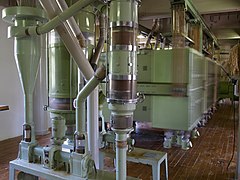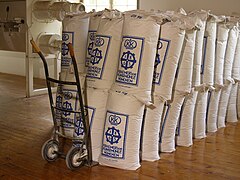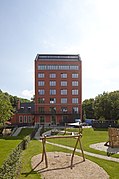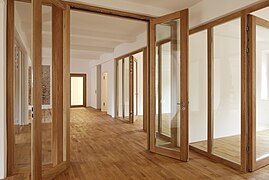Kraemer's art mill
The Kraemer'sche Kunstmühle was a flour mill in Munich . After it was closed in 2007, it was rebuilt and has been used as an office and commercial building since 2011.
location
The building complex is located in Munich's Untergiesing district on Auer Mühlbach near the edge of the Isar high bank at Birkenleiten 41. Access is from Schönstraße via Lebschéestraße. The buildings stand on an island that is formed by the Auer Mühlbach and a branch branched off from it, the Kunstmühlnebenbach.
The approximately 37,000 m 2 area belonging to the Kraemer'schen Kunstmühle is located on both sides of the Auer Mühlbach. A large part of the site, like many other bank areas of the Auer Mühlbach , is protected as part of the Natura 2000 network of the EU .
The Orthopedic Clinic Munich-Harlaching and the Bavarian State School for the Physically Disabled are located directly above the Kraemer'schen Kunstmühle on the Isar high bank. A little to the north of the mill in Birkenleiten 35 is the Templar Archiconvent . South of the mill, an allotment garden stretches along the Auer Mühlbach stream to the Siebenbrunn garden restaurant at Hellabrunn Zoo .
description
The Kraemer'sche Kunstmühle essentially consists of four parts of the building that follow each other from north to south along the Auer Mühlbach. The northernmost structure is a successor building erected in 2012 for a silo tower that used to stand at this point. The former, completely renovated mill building, in which the grain was ground, adjoins to the south. A new building, completed in 2019, will follow further south. Adjacent to this is a warehouse where the flour packed in sacks used to be stored. A coffee roastery, a daycare center and a restaurant are housed on the total of approx. 5500 square meters of commercial space.
To the east of the mill building is a power station building over the Auer Mühlbach. To the west of the building complex is a single two-storey house in which executive employees of the mill used to live and which is now the headquarters of Kraemer'schen Kunstmühle GmbH & Co. KG. In the south of the building there is a larger open space on which several Valais black-nosed sheep are currently (2020) kept.
history
Paper mill
The mill was founded in 1701 by Baron Max von Mayr, the owner of Harlaching Castle , as a paper mill . The mill remained in family ownership for several generations, but was leased out at times. On June 7th, 1811 the mill burned down and was replaced by a new building.
In 1828 Markus von Mayr sold the mill to Michael Brandmiller, who had operated the mill since 1810. After his death, the mill became the property of Anton Buchner, who married Brandmiller's widow.
Flour mill
Anton Buchner sold the business to Carl Jakob Kraemer in 1863, who, like his father before him, was the tenant of the Cannstatt town mill . Since Munich was an important grain market at the time, Kraemer had the paper mill converted into a grain mill . The grinders originally used were soon replaced by roller mills. The mill was then allowed to use the term art mill .
Even then, the Kraemer'sche Kunstmühle already consisted of several buildings that were lined up along the Auer Mühlbach. The mill and residential building was roughly in an east-west direction, i.e. with the gable facing the Mühlbach. The mill was in the eastern part of the Mühlbach and the miller's apartment in the western part. A woodshed was built to the east of the mill house, in which the three water turbines used to drive the roller mills were located. The grain store south of the mill and dwelling house and the flour store north of it, on the other hand, were parallel to the Mühlbach. To the north of the flour store there was still a stable building across the Mühlbach. The stepped roofs of the mill and residential building and the flour store still showed the original use of these buildings as a paper mill, as the fresh sheets of paper were dried in the roof trusses and therefore required an increased air supply.
At the beginning of the 20th century, the mill had 18 employees and processed around 18-20 tons of wheat or rye every day. The ground flour was delivered with the company's own vehicle fleet, initially with carts pulled by horses and oxen, and later with our own trucks.
The mill was deliberately destroyed in the Second World War . The mill was badly damaged in a first bomb attack on November 22nd, 1944. Five days later, a second bomb attack followed, which razed the mill to the ground. After the war, the mill was rebuilt in 1945–1948. The new mill building was built on the site of the former flour warehouse. The topping-out ceremony for the mill building took place on April 17, 1948 . In 1949 the new turbine building was built. Instead of the previous three turbines, a Francis-type turbine was installed. The inauguration of the rebuilt mill took place on October 1, 1949. The original grain store was rebuilt as a single storey and then served as a flour store. It was connected to the mill building via a one-story wing. The 36 m high silo tower for storing the grain was built in 1960. It became a landmark of the mill that can be seen from afar.
The mill now processed around 160 tons of grain a day.
- owner
The Kraemer'sche Kunstmühle is still owned by the Kraemer family, currently (2020) in the fifth generation. After the company's founder, Carl Jakob, his sons Friedrich and Otto took over the business. Friedrich left the company in exchange for a severance payment, and after Otto, his sons Heinz and Walter continued the business. Her successors were Reinhard, son of Heinz, and Thomas, son of Walter. Today Thomas and Reinhard's son Markus are joint managing directors of the company.
Decommissioning and subsequent use
Because of the increasingly difficult and expensive grain supply at the Munich location and because of the structural change in the baking industry (there were around 700 baking companies in Munich in 1960, only around 40 in 2007), the Kraemer family decided to shut down the company in 2007. This left the Hofbräuhaus-Kunstmühle as the last producing mill in Munich.
From 2010 to 2012 the Kraemer'sche Kunstmühle was rebuilt and supplemented by a south tower in 2019. A coffee roastery, a restaurant and a day-care center, among others, architects, engineers and advertising agencies are housed on the almost 5,500 square meters.
power plant
The mill had its own run-of-river power plant and generated around a quarter of the required electrical energy with its own water turbine and generator from the Auer Mühlbach . The power station building connects to the east wall of the mill building and extends over the Auer Mühlbach.
After the mill was shut down, the old generator and the old gearbox with flywheel, which transferred the movement of the turbine to the generator, were replaced by a new generator and a new gearbox in 2009. The generator delivers an average output of 130 kW, which is fed into the public grid.
See also
Web links
- Official website
- Kraemer's art mill. In: www.auer-muehlbach.de. Team Auer Mühlbach, accessed on October 16, 2010 .
- Barbara Bredl: The most modern know-how. In: Münchner Stadtanzeiger. February 15, 1996, accessed October 16, 2010 .
Individual evidence
Coordinates: 48 ° 6 ′ 20 ″ N , 11 ° 34 ′ 1 ″ E


















